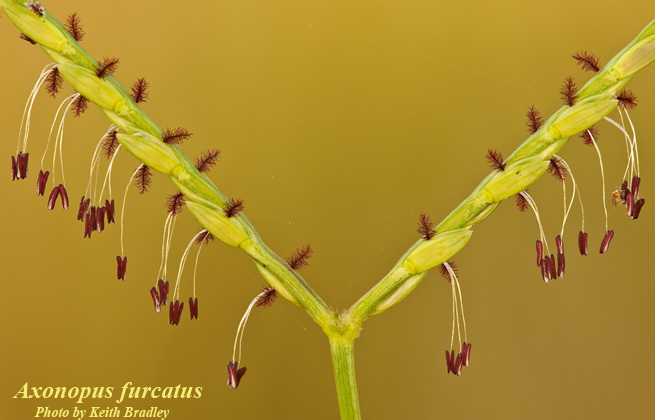Axonopus furcatus
Common names: Big Carpetgrass
| Axonopus furcatus | |
|---|---|

| |
| Photo by the Atlas of Florida Plants Database | |
| Scientific classification | |
| Kingdom: | Plantae |
| Division: | Magnoliophyta - Flowering plants |
| Class: | Liliopsida - Moncots |
| Order: | Cyperales |
| Family: | Poaceae |
| Genus: | Axonopus |
| Species: | A. furcatus |
| Binomial name | |
| Axonopus furcatus (Fluegge) Hitchcock | |
Contents
Taxonomic Notes
Synonym: Paspalum furcatum (Flügge).[1]
Varieties: none.[1]
Description
A. furcatus is a perennial graminoid of the Poaceae family native to North America. [2]
Distribution
The A. furcatus is found along the Coastal Plains of Virginia to Florida and west to Texas and Arkansas[2] with disjunct populations in western Cuba.[3]
Ecology
Habitat
A. furcatus can be found in maritime forests, sandy forest, bottomlands, calcareous wet meadows and other coastal regions. [4] It has been found in plant communities including pine, palmetto, and wet prairie. [5] Recorded habitats include longleaf pine sandhills with wet depressions, cypress swamps, rich pasture, standing water, deciduous wooded bottoms on sandy levee, ponds, banks of rivers, and wooded floodplains. [6] A. furcatus was found to increase its occurrence or be unaffected in response to soil disturbance by roller chopping in South Florida. It has also shown either additional regrowth or no change in growth in reestablished native forests that were disturbed by roller chopping.[7]
Axonopus furcatus is frequent and abundant in the Calcareous Savannas community type as described in Carr et al. (2010).[8]
Phenology
This species has been observed to flower in June.[9]
Fire ecology
A study found A. furcatus to be more abundant in sites that were winter burned and grazed.[10]
Herbivory and toxicology
A. furcatus is considered to be of fair forage value.[5]
Conservation, cultivation, and restoration
It is listed as endangered and extirpated by the Maryland Department of Natural Resources.[2]
Cultural use
Photo Gallery
References and notes
- ↑ 1.0 1.1 Weakley, A.S. 2015. Flora of the southern and mid-atlantic states. Working Draft of 21 May 2015. University of North Carolina at Chapel Hill, Chapel Hill, North Carolina.
- ↑ 2.0 2.1 2.2 USDA Plant Database
- ↑ Sorrie, B. A. and A. S. Weakley 2001. Coastal Plain valcular plant endemics: Phytogeographic patterns. Castanea 66: 50-82.
- ↑ Weakley, A. S. (2015). Flora of the Southern and Mid-Atlantic States. Chapel Hill, NC, University of North Carolina Herbarium.
- ↑ 5.0 5.1 Hilmon, J. B. (1964). "Plants of the Caloosa Experimental Range " U.S. Forest Service Research Paper SE-12
- ↑ URL: http://herbarium.bio.fsu.edu. Last accessed: June 2018. Collectors: Loran C. Anderson, Cecil R Slaughter, Jason R. Swallen, Robert Kral, Sidney McDaniel, Robert K. Godfrey, G. W. Reinert States and counties: Florida (Alachua, Osceola, Collier, Madison, Jackson, Leon, Nassau, Franklin)
- ↑ Lewis, C.E. (1970). Responses to Chopping and Rock Phosphate on South Florida Ranges. Journal of Range Management 23(4):276-282.
- ↑ Carr, S.C., K.M. Robertson, and R.K. Peet. 2010. A vegetation classification of fire-dependent pinelands of Florida. Castanea 75:153-189.
- ↑ Nelson, G. PanFlora: Plant data for the eastern United States with emphasis on the Southeastern Coastal Plains, Florida, and the Florida Panhandle. www.gilnelson.com/PanFlora/ Accessed: 26 MAR 2019
- ↑ Boughton, E., et al. (2013). "Season of fire and nutrient enrichment affect plant community dynamics in subtropical semi-natural grasslands released from agriculture." Biological Conservation 158: 239-247.